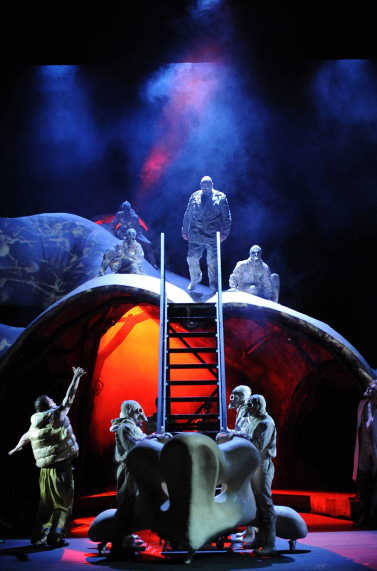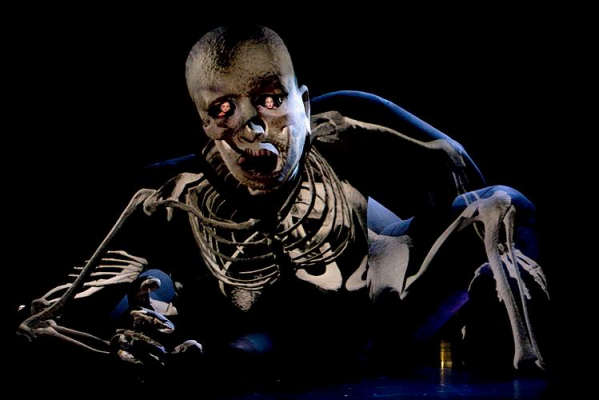Other Links
Editorial Board
- Editor - Bill Kenny
- Deputy Editor - Bob Briggs
- Founder - Len Mullenger
Google Site Search
SEEN AND HEARD UK OPERA REVIEW
Ligeti, Le grand macabre: Soloists, Chorus and Orchestra of English National Opera. 17.9.2009 (CC)
Conductor: Baldur Brönnimann
Directors: Alex Ollé (La Fura dels Baus), Valentina Carrasco
Designer: Alfons Flores
Lighting: Peter Van Praet
Video Designer: Franc Aleu
Cast:
Piet the Pot: Wolfgang Ablinger-Sperrhacke
Amando: Frances Bourne
Amanda: Rebecca Bottone
Nekrotzar: Pavlo Hunka
Astradamors: Frode Olsen
Mescalina: Susan Bickley
Venus, Gepopo: Susanna Andersson
Prince Go-Go: Andrew Watts
White Minister: Daniel Norman
Black Minister: Simon Butteriss
Ruffiack: Michael Burke
Schobiack: Christopher Speight
Schabernack: Andrew Tinkler

Ligeti’s Le grand macabre is a stunning piece of theatre, and it was the sheer theatricality of the Catalan company La Fura dels Baus’ production of this ‘anti anti-opera’ that one takes away from this enthralling evening. It is difficult to imagine a more spectacular beginning to ENO’s 2009/10 season. The performance begins with a projected film of a woman gorging on junk food. We see what looks like a heart attack – surely she is dead?. And yet at the end we find out she lives, an allegory for Ligeti’s central theme of the expected end of the imagined, surreal world of ‘Breugelland’ via an approaching comet. The opera examines our concerns as humans not only with death but also with the decomposition of our form. Towards the end of the opera the characters believe themselves dead, only to reason that the dead don’t get hungry or thirsty, so they must be alive after all (and so it is).
The sheer expertise of the initial film’s heroine’s face being morphed into the face of the on-stage, huge ‘human’ construct of Claudia is breathtaking. The first impression of this massive figure is sheer bulk. At that stage we the audience have no idea as to the multitude of transformations we will see: at one point ‘she’ transforms into a ‘he’; at another, the body becomes transparent and we see bones; at yet another, two disconcertingly real eyes appear, lit up. (S)He deconstructs – intestines become visible, parts dislodge, nipples screw off revealing new entrance/exit points to the stage. The figure moves, after a fashion (thankfully for the integrity of ENO’s roof, it never stands up). At one point, flames are all over the body. The contrast with the tamer flames of the Royal Opera’s recent Don Carlo in the auto-da-fe scene was stark, and I could not help noticing that the conductor of that particular production, Semyon Bychkov, was in the audience. I wonder if he made that link, too?. People (the Black and White Ministers, Simon Butteriss and Daniel Norman) emerge from the on-stage figure’s anus - this is one woman who really does have a big arse - to engage in a shared alphabetical catalogue of swear-word insults. Those who balk at swearing should probably not attend, but those who can take it will find themselves amused. I particularly liked Piet’s comment of “Oh God, now we’re fucked” when he adds a timer to Nekrotzar’s “requisite” scythe.

Here in Breughelland everything is distorted. The arrival of a pocket-sized version of Nekrotzar towards the end is superbly managed. Amanda and Amando, both sung by females (soprano Rebecca Bottone and mezzo Frances Bourne respectively) who initially hunt for a spot to have sex before helping themselves to a coffin, are dressed in costumes that imply Gunther von Hagen’s infamous “Body Worlds” exhibition. Most overtly, musically, this sense of distortion comes in a Ligetian version of the Can-Can from Offenbach’s Orphée aux Enfers, but the recontextualisation of sound also plays a part in Ligeti’s thought (and gives rise to possibly the most famous aspect of Le grand macabre, the use of a battery of car horns in the orchestra). Ligeti’s sonic palette is huge and should be instantly identifiable. The orchestra seemed to blunt some of the edges that Salonen in his recording so enjoys, though, something which also lessens the contrasts (the passage, “Melting snow is thy breast” is beautiful in the kind of frozen way that Ligeti is so good at). Spacially separated brass gave an impression of the music opening out from the pit/stage and involving all in the Coliseum.
The vocal writing itself is, perhaps predictably, cruelly difficult. The cast was uniformly up to the task. The part of Venus is Ligeti’s version of the Queen of the Night and was expertly taken by a singer who has taken that very part elsewhere, Susanna Andersson. The tenor Wolfgang Ablinger-Sperrhacke was excellent as Piet the Pot, but even he was eclipsed by the strong talents of bass-baritone Pavlo Hunka as Nekrotzar.
Despite the excellence of the singers, the overall impression was one of a superb company effort, something for which ENO is justifiably famous. There are five remaining performances (September 22, 25, Oct 1, 3 and 9). If all was right with the world, attendance would be compulsory for all over-18s. For those a little afraid of so-called “modern” music, I should point out that very few people seemed to have left at the interval. This is a hypnotically gripping evening that should not be missed. You will laugh and be horrified in equal measure.
Colin Clarke
Picture © Stephen Cummiskey
Back to Top
Cumulative Index Page
